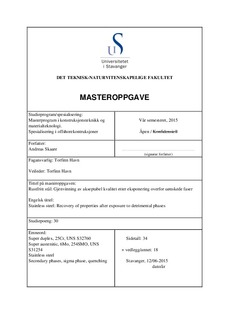| dc.contributor.author | Skaare, Andreas | |
| dc.date.accessioned | 2015-09-30T14:12:45Z | |
| dc.date.available | 2015-09-30T14:12:45Z | |
| dc.date.issued | 2015-06-12 | |
| dc.identifier.uri | http://hdl.handle.net/11250/1244183 | |
| dc.description | Master's thesis in Offshore structural engineering | nb_NO |
| dc.description.abstract | High alloyed stainless steel provides a desirable combination of corrosion resistance and mechanical properties, being a preferred material when ductility, overall strength and resistance to harsh environments are required. High service temperatures where alloy elements, as chromium and molybdenum, are present, is a well-known recipe for the precipitation of detrimental phases in the material. Even a small amount of these precipitations may impair the mechanical and corrosion properties.
The main objective with this thesis is to investigate the possibility to recover the initial properties after detrimental phases have transformed part of the materials microstructure. Different stages of detrimental phases are intentionally provoked to achieve a wider spectra of analysis.
In order to quantify the damage and recovery, material is evaluated metallographically and by performing Charpy V-notch impact test, where the first mentioned gives us the exact amount of sub phases that has appeared in the microstructure and the latter gives us an idea of the behavior of the material, due to a sharp decrease in toughness led by the growth of detrimental phases in the given structure.
The theory behind steel restructuration proves to be right, showing that the microstructure and any detrimental phases can be dissolved by performing a correct heat treatment at a sufficiently high temperature with the correct cooling.
The first material, UNS S32760, is able to recover up to 86% percent of its toughness no matter what the previous exposure to detrimental phases was. All previous detrimental phases retreat when proper heat treatment is applied. The lack of toughness recovery is due to the precipitation of a new detrimental phase, chrome nitride. This precipitation is due to the saturation of nitrogen in ferrite grains when a fast cooling is applied.
Samples from the second material, UNS S31254, were subjected to the same heat treatments. Results show lower propensity to formation of detrimental phases and an overall recovery of the microstructure compared to factory standards. | nb_NO |
| dc.language.iso | eng | nb_NO |
| dc.publisher | University of Stavanger, Norway | nb_NO |
| dc.relation.ispartofseries | Masteroppgave/UIS-TN-IKM/2015; | |
| dc.subject | materialteknologi | nb_NO |
| dc.subject | konstruksjonsteknikk | nb_NO |
| dc.subject | offshorekonstruksjoner | nb_NO |
| dc.subject | stainless steel | nb_NO |
| dc.subject | rustfritt stål | nb_NO |
| dc.title | Stainless steel: Recovery of properties after exposure to detrimental phases | nb_NO |
| dc.title.alternative | Rustfritt stål: Gjenvinning av akseptabel kvalitet etter eksponering overfor uønskede faser | nb_NO |
| dc.type | Master thesis | nb_NO |
| dc.subject.nsi | VDP::Technology: 500::Marine technology: 580::Offshore technology: 581 | nb_NO |
